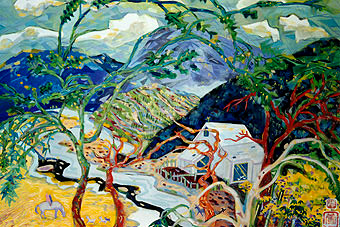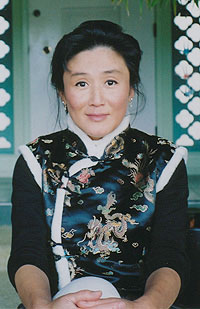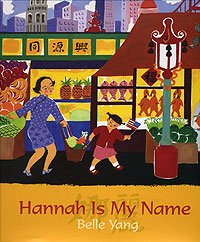|

Carmel Valley 2004 is one
of Belle Yang's works
|
January 10, 2005
New children’s book by alumna writer/artist
Belle Yang tells moving tale of immigrant experience
By Scott Rappaport
A remarkable new book by UCSC alumna Belle Yang taps into the
hopes and fears all immigrant children must experience when
they try to grab hold of the American dream.

Writer/artist Belle Yang has written
a children's book based on her own experiences. Photo:
Laning Yang
|
 |
Drawn from Yang’s own saga of coming to San Francisco
from Taiwan at the age of seven, Hannah Is My Name tells
the story of a Chinese family’s new life in a brightly
illustrated 32-page children’s book published by Candlewick
Press.
Told entirely from the child’s point of view, it’s
a wonderfully upbeat tale that describes the obstacles faced
as the family members adapt to a new way of life and anxiously
wait for their green cards to avoid deportation.
Yang herself adapted well to American academia, earning a 4.0
grade-point average in high school and accepting a Regents Scholarship
to attend UCSC in the late 1970s. Although she eventually earned
a B.A. in biology, her life was changed forever when she spent
her junior year abroad studying in Scotland. While traveling
through Spain, Yang realized that she had fallen in love with
the art, architecture, museums, and galleries of Europe.
“I was always very good at art but thought it would be
my hobby and not my life,” said Yang. “As an immigrant,
my parents had hoped for me to have a stable career in medicine.
But I found my voice because I was really strong in the arts,
and not necessarily as a scientist.”
Upon her return to the United States, Yang finished her degree
at UCSC and went on to study at the Art Center College of Design
in Pasadena, as well as the Institute of Traditional Chinese
Painting in Beijing. She traveled throughout China and was particularly
enthralled by Hunan Province and the Gobi Desert. “I think
China defined my style,” said Yang, “particularly
the folk art which is bright and cheerful. It’s fun and
whimsical, whereas traditional Chinese painting is very restrictive
because each brushstroke must be perfect from years of studying
calligraphy.”
Yang spent three years exploring art in China, but returned
to her parents’ home in Carmel Valley after the Tiananmen
massacre in 1989. “I had seen friends in China who weren’t
allowed to write or paint, so when I came back, I made a vow
that I’d make use of my freedom,” Yang noted. But
following her parents’ advice, she agreed to stay with
them for one year in order to decide what to do with her future.
“One night there was a power failure, so my father began
telling stories,” Yang recalled. “When the power came
back on, I immediately wrote down the story and painted a painting
to go with it. I soon asked my father for more stories about
his childhood. So I began to write more down and make more paintings.”
Yang would eventually send some of these vignettes with paintings
to a friend she had met in Beijing, who happened to be the wife
of the ambassador to China. Eventually her work ended up in
the hands of Amy Tan, the acclaimed author of The Joy Luck
Club. “She wrote me a really nice letter and said she
could help me when I was ready to be published,” Yang said.
“Two years later, I finished my collection of stories and
paintings and sent it to her. She gave it to her agent, and
he sent it to Harcourt Brace.”
The result was Yang’s first book, Baba: A Return to
China Upon My Father’s Shoulders, published in 1994
and widely reviewed in major newspapers across the country.
The Los Angeles Times called the book “captivating…rich
in humanity…lavishly illustrated and lovingly narrated…
evoking the sights, sounds and motions of a lost childhood.”
Yang followed up with another book in 1996, The Odyssey
of a Manchurian, the story of her father’s flight from
civil war as a young man in China. And she recently finished
the third book of this trilogy that has yet to be published--a
story of old China through the eyes of her great-grandfather.
Recalling her days as a student at UCSC, Yang had high praise
for a class she took from UCSC professor Dilip Basu titled Modern
Chinese History--crediting it as “a life-altering course
because it made me realize how deeply rooted I was in Chinese
culture.” She also noted that her first book was used in
a freshman core course at Porter College and turned into a play
by UCSC theater arts professor Kathy Foley. Called The Flight
of the Monkey King, the play was performed on campus in
1994.
Over the years, Yang has experienced more than her share of
trials--she was seriously stalked for five years by an ex-boyfriend
and later suffered from an inexplicable immune disorder that
sent her to bed for nearly four years. But today Yang is healthy
again, working on new projects and doing publicity for her new
children’s book. She recently spoke with representatives
from the Los Angeles Unified School District about including
the book in their bilingual program.
“My philosophy is that whenever I’m uncomfortable,
I say to myself--‘don’t resent it, pay attention,
there’s a story here,’” Yang noted. “Negative
experiences have always made me pick myself up again and push
harder.”
“It’s nice to be older,” Yang added. “I
feel happy to be 44 and alive. I only want more time to write
and paint.”
Return to Front Page